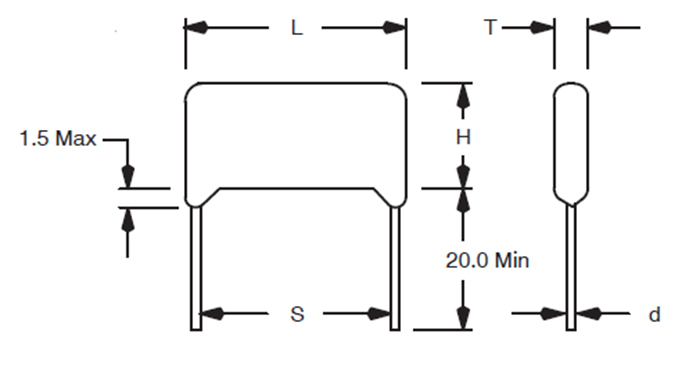Mylar Capacitors a.k.a polyester capacitors (PET) are special type of capacitors with some unique features compared with ceramic and electrolytic capacitor. They can withstand high voltages in a relatively small package and provides high resistance against moisture.
Pin Configuration
The Mylar Capacitors has no polarity similar to the ceramic capacitors. Meaning they can be connected in any direction. They are breadboard friendly and can be easily used on a perf board also. The symbol for mylar capacitoris just two plain lines as shown above since they do not have any polarity.
Note: There are many types of capacitors; the Mylar capacitor is a special type of capacitor with unique properties
Mylar capacitor Features
- Capacitance Range: 0.001uF to 5.6uF
- Voltage Range: 50V to 630V
- Tolerance: ±10%
- Dielectric constant: 3.2 at 1MHz
- Dissipation factor: 0.5 at 1kHz
- Capacitance drift: 1.5
- Operating Temperature: 125°C (max)
Note: More details can be found at datasheet linked below.
What is a Mylar capacitor?
Mylar capacitor is a special type of capacitor right from its construction. As we know as capacitor is nothing but two parallel plates separated by a dielectric medium. The dielectric medium used in this type of capacitor is Polyester hence it is also called as polyester capacitor. Although there are many types of polyester the term “Polyester” here refers to Polyethylene terephthalate which stands for PET.
Because of this PET the capacitor has some special properties which make it suitable for certain applications. The same is discussed below.
Difference between Mylar/Polyester capacitor and other capacitors
Although the ceramic and the Electrolytic are the most commonly used capacitors, the Mylar capacitor has its own applications because of the following unique properties. A Mylar capacitor has high dielectric strength; hence we can build high voltage capacitor in a smaller package compared to electrolytic capacitors. These capacitors can also work in high temperatures upto 125°C with very little compromise on the voltage rating.
Unlike electrolytic capacitor the Mylar capacitors have very low ESR (Equivalent series resistance) making it suitable for high frequency filtering applications. Due to the property of Polyester the capacitor can withstand sharp voltage spikes and current pikes.
Applications
- High frequency filtering applications
- Outdoor applications where moisture is a problem
- High voltage/current peaks handling circuits
- Coupling and De-coupling circuits.
2D-Model
The size of the capacitor depends on the voltage rating of the capacitor. Please refer the mylar capacitor datasheetto know the dimensions of your Mylar capacitor.

Comments
Post a Comment